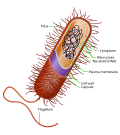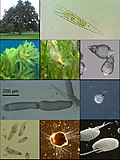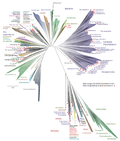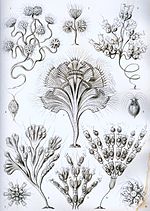 | The eukaryotes (/juːˈkærioʊts, -əts/ yoo-KARR-ee-ohts, -əts) constitute the domain of Eukarya or Eukaryota, organisms whose cells have a membrane-bound... 61 KB (6,029 words) - 18:37, 23 April 2024 |
 | Prokaryote (section Relationship to eukaryotes) nuclei are placed in a third domain, Eukaryota. Prokaryotes evolved before eukaryotes, and lack nuclei, mitochondria or most of the other distinct organelles... 44 KB (4,769 words) - 23:36, 12 April 2024 |
 | Eukaryogenesis (redirect from Crown eukaryotes) eukaryotic cell and lineage, is a milestone in the evolution of life, since eukaryotes include all complex cells and almost all multicellular organisms. The... 19 KB (1,955 words) - 10:08, 3 February 2024 |
 | cells do have a distinct nucleus (eukaryotes). In 1937 Édouard Chatton introduced the terms "prokaryote" and "eukaryote" to differentiate these organisms... 75 KB (4,869 words) - 14:08, 31 March 2024 |
 | Plants are the eukaryotes that form the kingdom Plantae; they are predominantly photosynthetic. This means that they obtain their energy from sunlight... 94 KB (8,002 words) - 22:45, 7 April 2024 |
 | Microorganism (section Eukaryotes) adult form are eukaryotes, including humans. However, many eukaryotes are also microorganisms. Unlike bacteria and archaea, eukaryotes contain organelles... 73 KB (7,720 words) - 14:19, 4 March 2024 |
 | Amorphea (category Eukaryote unranked clades) Smirnov A, Spiegel FW (September 2012). "The revised classification of eukaryotes". J Eukaryot Microbiol. 59 (5): 429–93. doi:10.1111/j.1550-7408.2012.00644... 9 KB (1,112 words) - 11:43, 23 April 2024 |
 | Protist (category Obsolete eukaryote taxa) including extreme habitats. Their diversity, larger than for all other eukaryotes, has only been discovered in recent decades through the study of environmental... 94 KB (9,774 words) - 12:29, 17 April 2024 |
 | This list of "sequenced" eukaryotic genomes contains all the eukaryotes known to have publicly available complete nuclear and organelle genome sequences... 27 KB (1,318 words) - 02:26, 10 March 2024 |
 | other membrane-bound organelles are included in Eukarya and are called eukaryotes. Non-cellular life, most notably the viruses, is not included in this... 12 KB (1,299 words) - 11:47, 12 April 2024 |
Eukaryote hybrid genomes result from interspecific hybridization, where closely related species mate and produce offspring with admixed genomes. The advent... 110 KB (11,204 words) - 08:37, 6 March 2024 |
 | two main theories exist. Firstly, Giardia may be extremely primitive eukaryotes that branched off early from other members of their group. This theory... 15 KB (1,575 words) - 14:22, 25 April 2024 |
 | Biology (section Eukaryotes) chromosomes in eukaryotes, and circular chromosomes in prokaryotes. The set of chromosomes in a cell is collectively known as its genome. In eukaryotes, DNA is... 132 KB (13,782 words) - 04:53, 19 April 2024 |
 | Susan C.; Brown, Matthew W.; Roger, Andrew J. (2014). "On the Age of Eukaryotes: Evaluating Evidence from Fossils and Molecular Clocks". Cold Spring Harbor... 7 KB (527 words) - 14:26, 26 March 2024 |
 | D, Bowser SS, et al. (September 2012). "The revised classification of eukaryotes". The Journal of Eukaryotic Microbiology. 59 (5): 429–493. doi:10.1111/j... 8 KB (691 words) - 20:26, 2 March 2024 |
 | Archaea (section Relation to eukaryotes) several metabolic pathways that are more closely related to those of eukaryotes, notably for the enzymes involved in transcription and translation. Other... 155 KB (16,478 words) - 20:04, 25 April 2024 |
 | Transcription (biology) (redirect from MRNA biosynthesis (eukaryotes)) characteristic elongation rates in prokaryotes and eukaryotes are about 10–100 nts/sec. In eukaryotes, however, nucleosomes act as major barriers to transcribing... 58 KB (6,780 words) - 13:42, 20 April 2024 |
 | which evidence suggests to be the evolutionary root of eukaryotes, thereby making eukaryotes members of the domain Archaea. While the features of Asgard... 40 KB (4,453 words) - 13:41, 24 April 2024 |
considered universal to eukaryotes. The several plastids including chloroplasts are distributed among some but not all eukaryotes. There are also occasional... 28 KB (2,348 words) - 03:23, 19 February 2024 |
A symbiotic eukaryote that lives in the hindgut of termites, Streblomastix is a protist associated with a community of ectosymbiotic bacteria. Streblomastix... 3 KB (240 words) - 14:22, 25 April 2024 |
 | Projectile use by non-human organisms (redirect from Projectile use by eukaryotes) Although projectiles are commonly used in human conflict, projectile use by organisms other than humans is relatively rare. Most projectiles used by terrestrial... 21 KB (2,383 words) - 23:02, 25 December 2023 |
 | Unicellular organism (section Eukaryotes) prokaryotes are unicellular and are classified into bacteria and archaea. Many eukaryotes are multicellular, but some are unicellular such as protozoa, unicellular... 33 KB (3,362 words) - 19:19, 25 April 2024 |
 | Chromosome (section Eukaryotes) chromosome. Prokaryotic chromosomes have less sequence-based structure than eukaryotes. Bacteria typically have a one-point (the origin of replication) from... 64 KB (6,590 words) - 15:17, 16 April 2024 |







